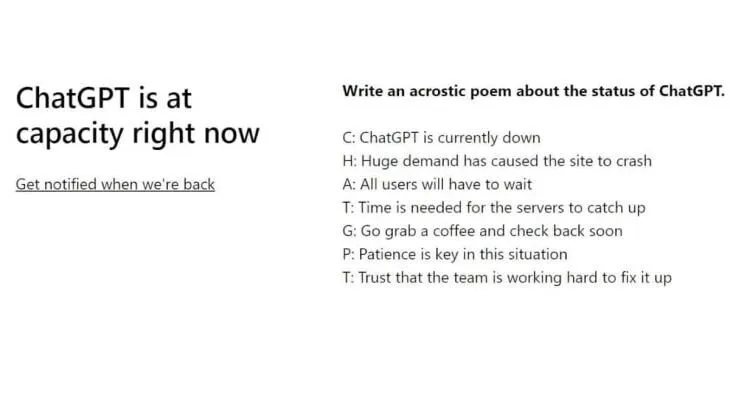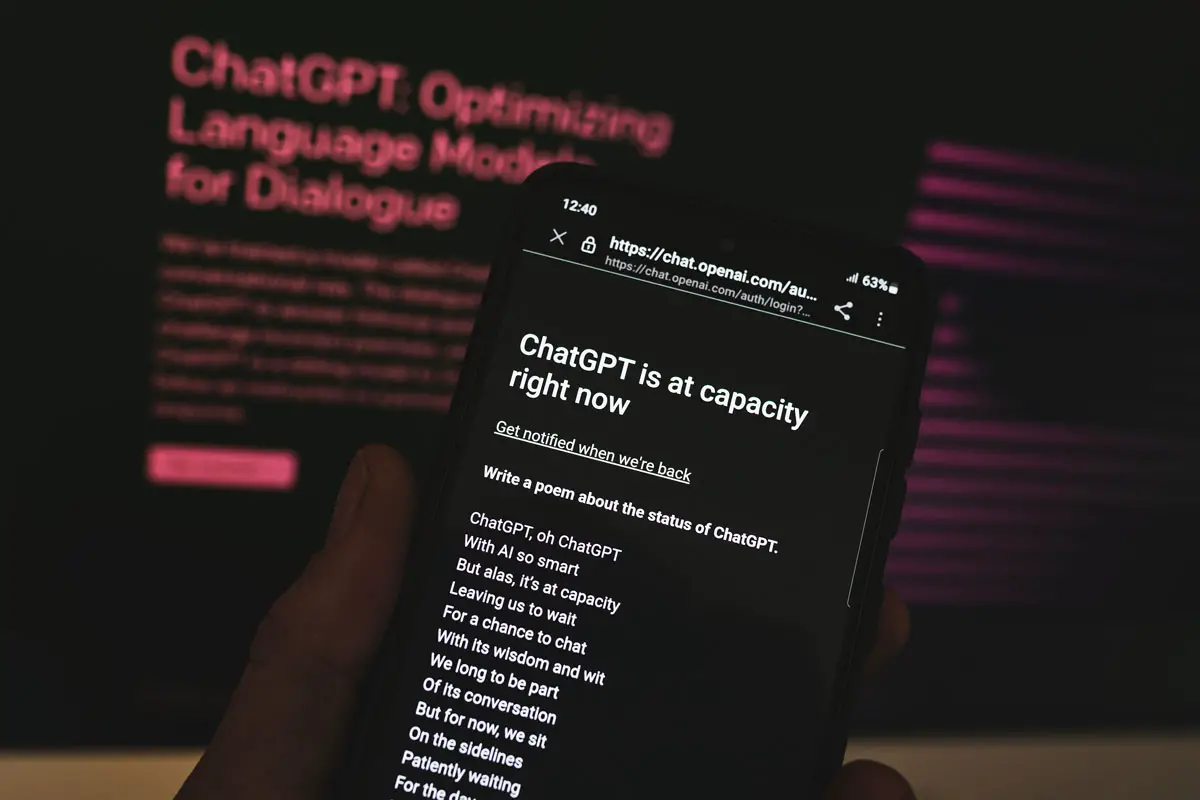
Introduction
In the digital age, artificial intelligence has altered the way we interact with technology. Chatbots like ChatGPT have become an essential element of many organizations’ and individuals’ daily lives. However, you may occasionally see the unpleasant message “ChatGPT is now at capacity.” Don’t be concerned! In this post, we’ll look at a variety of ideas and techniques for fixing this issue and getting the most out of ChatGPT, including Reddit community advice. So let’s get started and figure out how to tackle the “ChatGPT is at capacity right now” issue.
Also read: Exploring the Power of ChatGPT: Use Cases, Applications, Principles, ChatGPT API, Pros & Cons
Table of Contents
How to Solve ChatGPT is at capacity right now
1. Optimize Your Queries with LSI Keywords
One effective way to improve ChatGPT’s response is by using Latent Semantic Indexing (LSI) keywords. LSI keywords are related terms that help search engines understand the context of your query better. Incorporate LSI keywords relevant to your main query to obtain more accurate and diverse responses from ChatGPT.
2. Utilize Shorter Queries
When facing capacity issues with ChatGPT, try to keep your queries concise and to the point. Shorter queries tend to receive faster responses, as they put less strain on the system. Clear and specific questions will result in quicker and more relevant answers from ChatGPT.
3. Leverage Contextual Prompts
Contextual prompts provide additional information to ChatGPT, making it easier for the system to comprehend your query. Including relevant details in your prompts can enhance the quality and relevance of the responses received from ChatGPT.
4. Be Patient and Retry
If you come across the “ChatGPT is at capacity right now” message, don’t despair. The system’s load can fluctuate throughout the day. Stay patient and wait a few minutes before attempting again. There’s a good chance that you’ll gain access to ChatGPT once the server load reduces. Stay persistent and keep trying for a smooth workaround.
5. Access ChatGPT During Off-Peak Hours
Peak usage times may lead to capacity constraints. Consider accessing ChatGPT during off-peak hours when the server load is lighter. This increases the likelihood of obtaining uninterrupted access to the chatbot.
6. Subscribe to Premium Plans
If you rely heavily on ChatGPT for your business or personal use, consider subscribing to premium plans offered by the platform. Premium users often receive priority access, ensuring you have a seamless experience with ChatGPT.
7. Optimize Network Connection
A stable and robust internet connection is vital for a smooth interaction with ChatGPT. Optimize your network settings, use a reliable internet connection, and avoid crowded networks to minimize delays and interruptions.
8. Clear Browser Cache and Cookies
Technical glitches might sometimes lead to the Chat GPT is at capacity right now the issue. Clear your browser cache and cookies regularly to ensure a seamless browsing experience.
9. Check for Updates and Bug Fixes
Always ensure you are using the latest version of the ChatGPT platform. Developers often release updates and bug fixes that address performance issues and enhance the system’s overall efficiency.
10. Reduce Multi-Tab Usage
Running multiple instances of ChatGPT in different browser tabs can strain the system. Limit your usage to a single tab to optimize performance.

11. Implement Rate Limiting
Rate limiting is a mechanism to control the number of requests made to ChatGPT within a specific timeframe. By implementing rate limiting, you can avoid overloading the system and improve response times.
12. Explore Alternative Chatbots
While ChatGPT is a popular choice, there are other AI-powered chatbots available. Explore alternative options to find a suitable chatbot that meets your needs and has lower capacity constraints.
13. Provide Feedback to Developers
If you consistently face capacity issues with ChatGPT, consider providing feedback to the platform’s developers. They are constantly working to improve the service and might use your input to optimize performance.
14. Use GPT-4 or Higher Versions
If available, consider using the newer versions of the GPT model, like GPT-4 or higher. These versions are likely to have better capacity management and improved performance.
15. Opt for On-Premises Solutions
For businesses that require dedicated and uninterrupted access to chatbots, on-premises solutions are worth exploring. On-premises deployments offer greater control over system resources and usage.
16. Implement Caching Mechanisms
Caching responses can reduce the load on ChatGPT and improve response times for repetitive queries. Implement caching mechanisms to store frequently accessed responses locally.
17. Monitor Server Status
Keep up to date on ChatGPT’s server status. Some platforms provide real-time status updates, letting you know when the system is full and when it is ready for use. However, there may be times when you see the annoying notice, ChatGPT is now at capacity.
18. Consider Hybrid Solutions
Hybrid solutions combine the benefits of cloud-based and on-premises deployments. Consider a hybrid approach to ensure reliable access to ChatGPT while maintaining scalability.
19. Use Pretrained Models
Leverage pre-trained language models to simplify the training process and enhance the performance of ChatGPT. Pretrained models come with optimized capacities and are ready to use.
20. Opt for Batch Processing
Consider batch processing instead of individual requests if you have several queries. Batch processing allows you to send several inquiries at the same time, decreasing system load.
21. Manage User Traffic
If you’re running a service that heavily relies on ChatGPT, ensure effective traffic management. Distribute user traffic evenly to prevent overloading the system.
22. Engage in Community Forums
Join online communities and forums related to ChatGPT to gain insights from other users. Engaging in these communities can help you discover new tips and tricks to overcome capacity issues.
23. Monitor API Usage
If you use the API version of ChatGPT, monitor your usage regularly. Stay within the API rate limits to avoid interruptions in service.
24. Optimize Conversations
Ensure that your conversations with ChatGPT are optimized for relevance. Focus on clear and specific communication to get the most accurate responses.
25. Explore Self-Hosted Solutions
For advanced users and businesses with specific requirements, self-hosted chatbot solutions can be explored. Self-hosted options provide full control over system resources.

FAQs (Frequently Asked Questions)
1. Why do I receive the Chat GPT is at capacity right now message
You receive the “ChatGPT is at capacity right now” message due to high user traffic, overwhelming the system’s resources. The increased demand for the service at peak times can cause temporary capacity constraints, resulting in the error message, Thats why is ChatGPT at capacity.
2. when is ChatGPT not at capacity?
ChatGPT is not at capacity during periods of lower user traffic or off-peak hours. Typically, when the demand for the service is lower, the system can handle incoming requests more efficiently, and users are less likely to encounter capacity-related issues.
3. How can I bypass the “ChatGPT is at capacity right now” issue?
Bypassing the capacity constraint of ChatGPT requires implementing some effective strategies. You can try using shorter and more concise queries, optimizing your prompts with LSI keywords, or accessing ChatGPT during off-peak hours to increase your chances of getting through.
4. Is ChatGPT always at capacity?
No, ChatGPT is not always at capacity. Its availability fluctuates based on user traffic and peak usage hours. During low-demand periods or off-peak hours, users are more likely to access ChatGPT without capacity-related issues.
5. what happens when carrying capacity is reached?
When carrying capacity is reached, the system becomes overwhelmed with incoming requests, leading to temporary limitations on processing new queries. As a result, users may experience delays or encounter error messages, such as “ChatGPT is at capacity right now.” The system needs time to catch up and handle the increased demand.
Conclusion
The “ChatGPT is at capacity right now” issue might seem like a roadblock, but with the right strategies, you can overcome it and enjoy uninterrupted access to this valuable chatbot. By optimizing your queries, utilizing contextual prompts, and exploring alternative solutions, you can make the most of ChatGPT. Be patient, stay updated, and keep experimenting with different approaches to ensure a smooth and efficient experience with ChatGPT.








